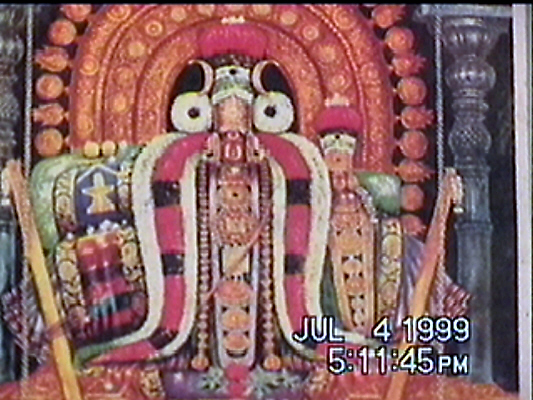Three
of the shrines at the Tiruvarur temple complex are of great significance. They are the Vanmikanathar,
Tyagarajar and the Kamalaamba shrines respectively.
The primary and the most ancient of the
shrines at Tiruvarur is that of Vanmikanathar.
Vanmikanathar is addressed in the Tevaram hymns of the
7th century CE as Aaruran or Tirumoolattaanamudaiyaar or
Putridamkondaar.
Vanmikanathar is represented as a prithvilingam or an
anthill, alluding to the ophiolatry practice of anthill worship of very ancient times.
This deity is associated directly with the legend
of Shiva appearing in an anthill and restoring Vishnu to
life upon being requested by the Gods or the Devas. The Aatakeswaram
shrine in the Tiruvarur temple, is believed to be the shrine from wherein Shiva appeared
in the main shrine, in the anthill.
In the main shrine dedicated to Vanmikanathar,
there is an image of Bhoga Shakti (Piriyaa Vidai Amman) representing
Shiva's consort. This image is permanently housed in the main shrine itself, and is also
referred to as Padi Taandaa Pattini.
Tyagaraja or Somaskanda
is the deity by whose name, the temple is known. References to Tyagaraja
as Veedhi Vitankar are seen in the hymns of Tirunavukkarasar
of the 7th century CE. The image of Tyagaraja here is related to the Mucukunda Chola legend and to
the Somaskanda legend of Vishnu being
blessed with a child.

Tyagaraja is the processional deity
representing Vanmikanathar and is taken out in procession on special
occasions. It is clear that over a period of time, the deity Tyagaraja
at Tiruvarur took precedence over the
moolavar Vanmikanathar as in Chidambaram,
where the processional image of Nataraja (taken out in procession only on
special occasions) takes precedence over the moolavar. The Tyagaraja and
the Vanmikanathar shrines form the center of the sacred space within the
temple.
Across from the Tyagaraja Sabha are
enshrined images of Sundaramoorthy Nayanaar, his consort
Paravai Naachiyaar and his friend Cheramaan
Perumaal Nayanaar.
The Achaleswarar shrine, or Aarur Araneri as
it is referred to in the Tevaram hymns is an ancient one. It was
renovated during the period of Sembian Mahadevi the ancient Chola queen.
The four shrines to Shiva at the cardinal points (with the sancta in the center) are Aatakeswaram,
Anandeswaram, Siddheeswaram and Achaleswaram.
Neelotpalaambaal or Alliyankodai (as referred to in the Tevaram
hymns) is enshrined in a shrine within the inner precincts of the temple. Neelotpalaambaal
is depicted as blessing her son Skanda.

Kamalaambaa is enshrined in a grand
shrine in the outer prakaaram. The Kamalaamba shrine is regarded with
great veneration and it has its own cycle of annual festivals. This shrine is also
referred to as a Shakti peetham and the suite of nine kritis composed by Mutthuswamy
Deekshitar sing praises of this deity.
Other shrines of importance here include those to Aingalakkaasu
Ganapati, Vaatapi Ganapati, the Navagrahams alligned in a row.
The Aingalakkaasu Ganapati is said to have been installed by Cheraman Perumaal
Naayanaar who collected 5 measures of copper coins and fashioned this image.
Vaatapi Ganapati represents the Stala Vinayakar of this shrine, enshrined
in the southwest corner of the inner prakaram. Enshrined in the 2nd prakaram is a shrine
to Rudra Durga.
